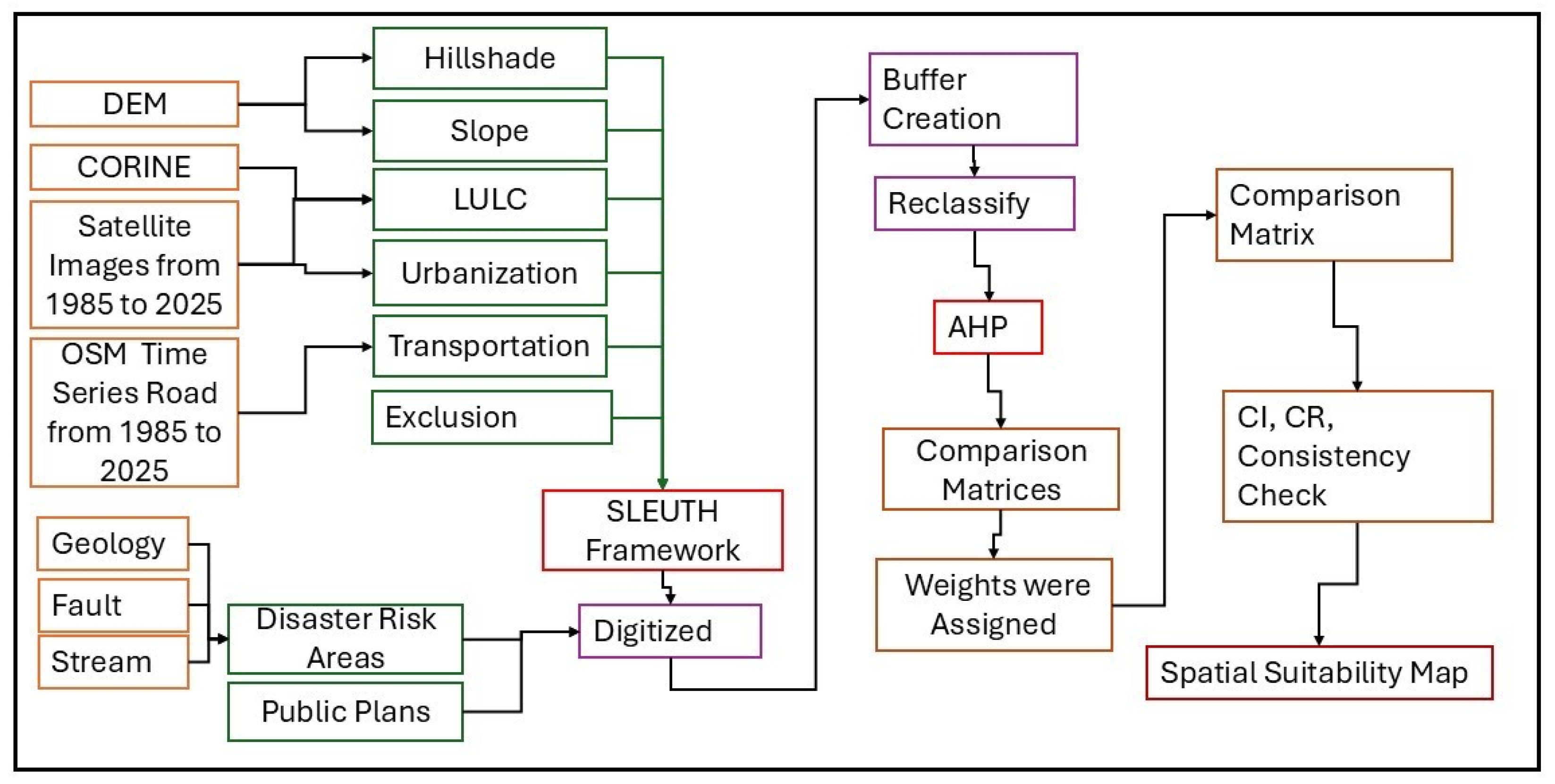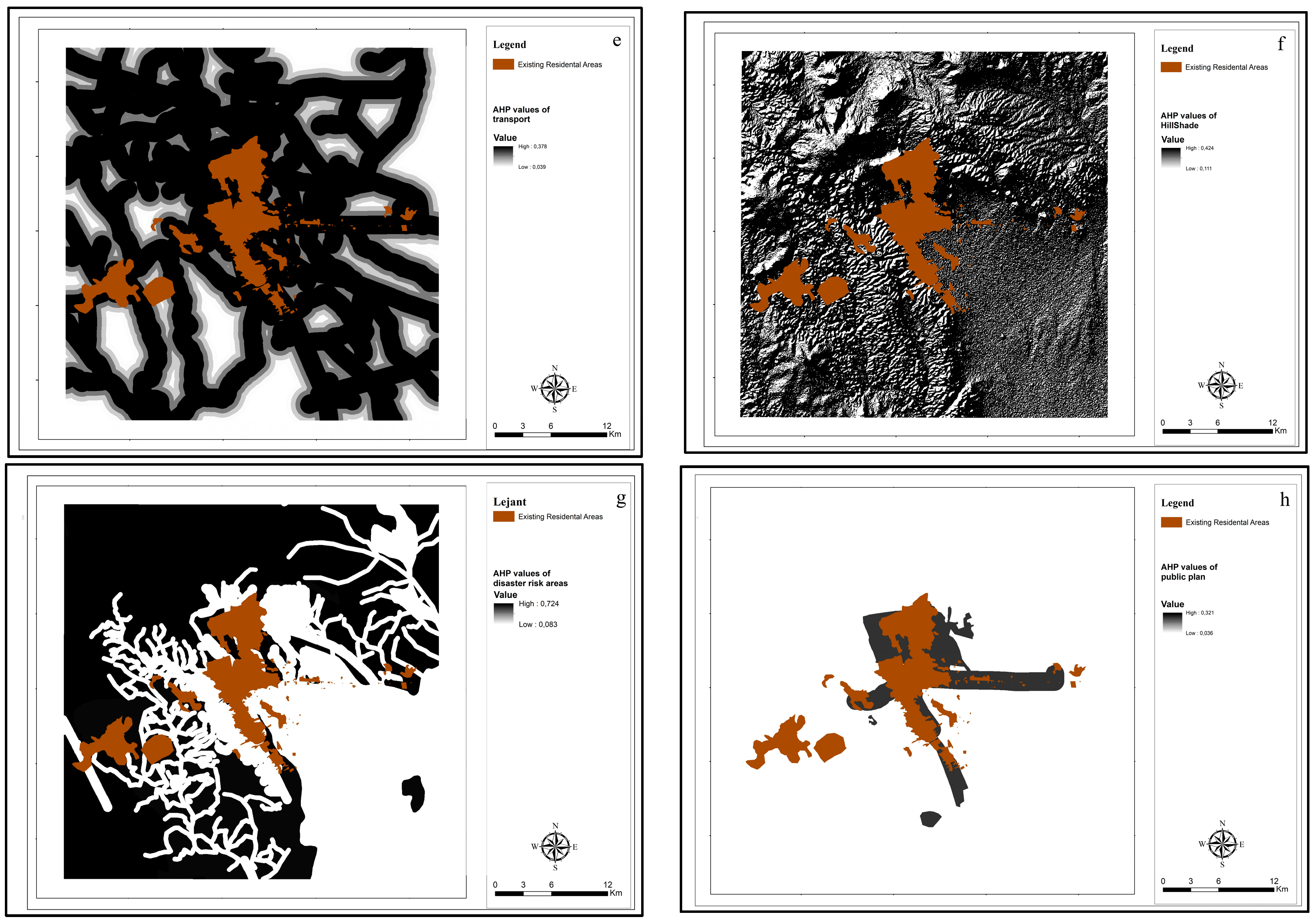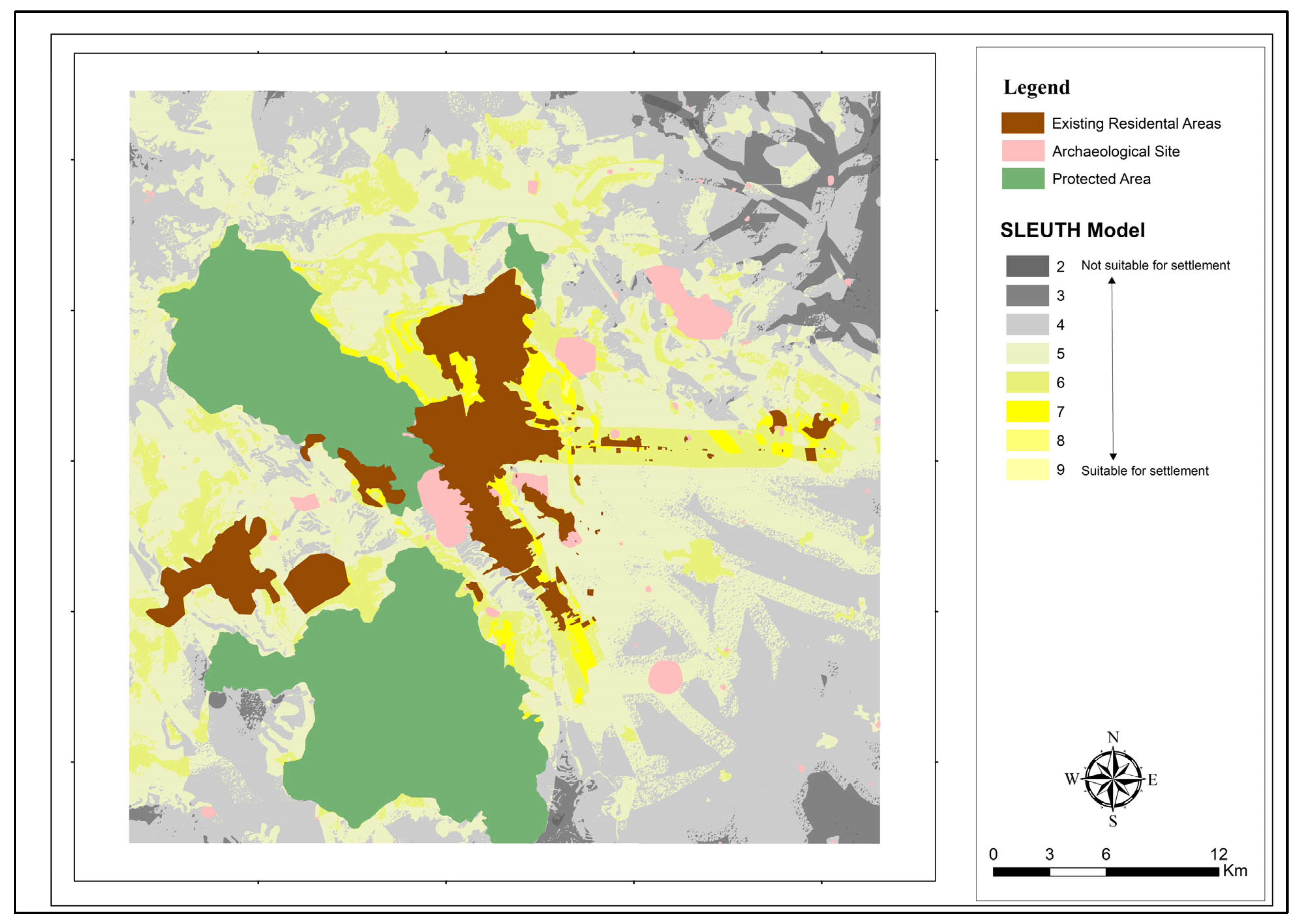2.3. Input Data
In this study, various spatial and temporal datasets were used for urban development prediction and settlement suitability analysis. Digital Elevation Model (DEM), CORINE land cover data, satellite imagery covering the period 1985–2025, and OpenStreetMap (OSM) time series road data constituted the main raster and vector data sources. The following thematic layers were derived from these data sets:
Hill shade and Slope: Using DEM data, topographic characteristics of the terrain were obtained.
Land Use and Cover (LULC): This was obtained by a classification process from CORINE and satellite images.
Urbanization: Urban sprawl areas were defined from satellite time series.
Transport Network (Transportation): Road networks and transport infrastructure were extracted from OSM data.
Excluded: Natural thresholds, protected areas, and no-building zones are collected in this layer. These layers constitute the input data required for the cellular automata-based SLEUTH model.
The data related to the city of Sanliurfa were organized, and the change in urban development was determined using raster and vector-based data. Accordingly, the first Landsat MSS, TM, ETM, and OLI/TIRS satellite images of the city of Sanliurfa for the years 1985, 1990, and 2000 were transferred to the ArcGIS 10.8 program, and the current area of the city of Sanliurfa for different years was determined. The city borders of the years 2010, 2020, and 2025 were drawn using the time shifter tool in Google Earth Pro Software. The data and data sources used in this study are given in
Table 1. Our selection was based on several considerations. First, Landsat imagery provides consistent temporal coverage and free access to historical data necessary for model calibration across multiple time points (1985, 1990, 2000, 2010, and 2020). Second, the 30 m resolution was sufficient for capturing generalized urban growth trends at the regional scale of our study area, in alignment with the policy-relevant spatial scale for land use planning and scenario assessment. Moreover, the satellite imagery was primarily used for updating land use/land cover information and delineating urban extents rather than for parcel-level urban morphology analysis. Given the regional planning focus of the study, where strategic land use decisions are made at the municipal or sub-regional level, the resolution employed aligns with the spatial granularity typically used in policy-oriented models.
SLEUTH is a model that simulates urban growth and surrounding LULC changes. A set of initial conditions and a growth cycle are developed for the simulation. Once these conditions are determined, a growth cycle, which is the basic unit of the SLEUTH model, is created [
33]. The model requires at least four urban layers of different periods, two separate transportation layers, and LULC, as well as a slope layer, a hill shade layer, and an excluded layer. In addition, disaster risk areas and public planning layers that will affect the development direction of the city were used as input layers in this study. All input layers were converted to raster format by assigning AHP values at the same urban coverage, resolution, and geographic coordinates. The data used in this study are shown in
Figure 3.
Slope data is obtained from the Digital Elevation Model (DEM). Pixel values are used as percentages. The critical slope determines the last point beyond which urban growth cannot progress due to the slope. In grayscale LULC images, each pixel value represents an LULC class. For example, in the case of using CORINE Level 1, LULC classes represent red, green, and blue bands (RGB) in the image, and the LULC class shows the LULC type associated with the RGB value. Pixel values take values between 0 and 255. LULC amounts in the study area are given in
Table 2. According to the table, the highest LULC amounts are irrigated agricultural areas, steppe, and dry agricultural areas.
The existing LULC data is classified between 1 and 5 in terms of suitability for settlement, where 1 represents the most suitable areas, and 5 indicates areas unsuitable for settlement. The classification was made based on the functional characteristics of each land use type, their proximity to essential infrastructure, and potential environmental constraints that may affect residential development. According to
Table 3, the LULC data was divided into five distinct groups, and an AHP comparison matrix was constructed accordingly. Class 1 includes areas that are in the immediate vicinity of current settlements, transportation routes, official institutions, healthcare facilities, dry farming zones, and existing construction sites. These areas were considered highly suitable due to their accessibility, infrastructure availability, and integration into the urban fabric. Class 2 comprises areas surrounding airports, sports and entertainment zones, and industrial and commercial units. While these locations offer proximity to economic and social facilities, they may involve moderate levels of noise or traffic, slightly reducing their settlement suitability. Class 3 includes steppe areas, which are open and generally available for development but lack immediate infrastructural support. Class 4 refers to the surroundings of orchards, which may be constrained by agricultural protection policies or water resource considerations, thus limiting their conversion into residential zones. Class 5 encompasses areas around mining sites, dumping grounds, urban green spaces, irrigated cultivated lands, forest areas, and wastewater treatment plants. These zones present significant environmental, legal, or health-related constraints that render them unsuitable for residential settlement.
The Excluded Areas layer defines areas that are suitable and unsuitable for urban growth. The Excluded Areas are not suitable for urban development due to environmental, legal, or physical constraints and are therefore excluded from future urban expansion scenarios in the SLEUTH model. In the layers, each pixel value is given specific weight values between 0 and 100 for the types of LULC, according to the level of protection and depending on the scenario created. As the value approaches 100, it indicates areas that will be excluded from urbanization, and as it approaches 0, it indicates areas with a high probability of urbanization. In the SLEUTH Model, each scenario is evaluated according to the extraction layers prepared for it [
34].
The Excluded Areas layer for the interpretation of the planning hypothesis in the SLEUTH Model layer needs to be created. This layer defines the areas where urban development is not possible. The areas that need to be protected from urbanization or the areas that are unsuitable for urbanization are shown with the extraction layer map for each scenario for the research area. The general approach in the application should be to define factors that either support urban growth (such as proximity to roads) or reject urban growth (restrictions in protected areas). Included in this study layer are Harran Plain, Balıklıgöl protection basin, wildlife protection areas, and archaeological sites. The most important of these sites is Göbeklitepe Archaeological Site, located 18 km northeast of Sanliurfa city center. The Harran Plain is one of the most important agricultural production areas of Türkiye. Therefore, the most striking situation in terms of LULC in the plain is the clear determination of the change in groundwater in the transition from dry farming to irrigated farming in terms of providing irrigation water.
In the urbanization model, the city size in the starting year is used. This layer is one of the basic layers used in determining urban growth with the SLEUTH Model. In the model, to understand the spatial characteristics of the data correctly, for the calibration phase where each data point is calibrated at three different spatial resolutions, the city layer belonging to the earliest year is used as the core layer, and the layers belonging to the following years (control years) are used to obtain the most appropriate statistical values reflecting the spatial characteristics of the city. Therefore, at least four city layers are needed in the calibration phase [
34]. The definition of the size of urban areas depends on the implementer who prepares the dataset. The model is basically classified in two ways as urban/non-urban [
34]. In
Table 4, the urban LULC rates of Sanliurfa city by year are given.
To start the model, the city size in the starting year is used. This layer is one of the basic layers used in determining urban growth with the SLEUTH Model. In the model, to correctly understand the spatial characteristics of the data, for the calibration stage where each data is calibrated at three different spatial resolutions, the city layer of the earliest year is used as the core layer, and the layers of the following years (control years) are used to obtain the most appropriate statistical values reflecting the spatial characteristics of the city. Therefore, at least four city layers are required in the calibration stage [
34].
For transportation, the road-dependent growth dynamics in the model draw attention to the regions with high accessibility, simulating the urban development trend. To determine the effect of accessibility on urban development in the calibration, road layers that change with urban development over time are preferred. The model starts with the road layer of the earliest date.
The road-dependent growth dynamics in the model simulate the urban development trend by drawing attention to areas with high accessibility. To determine the effect of accessibility on urban development in the calibration, road layers that change with urban development over time are preferred. The model starts with the road layer of the earliest date. With the growth cycle or the passage of time, road layers of later dates are obtained. The new layer is included in the process and read, and development begins from here [
34].
Transportation infrastructure is vital to the economic growth and prosperity of cities, especially in developing regions of the world. Transportation investment accounts for 40 percent of public sector expenditures [
35,
36]. Adequate transportation infrastructure is especially important in the world’s megacities, where annual motorization rates of 10 to 15 percent are not uncommon [
36]. But the road capacity of megacities has failed to keep pace with the massive increases in traffic, and worsening traffic congestion threatens economic productivity and the overall quality of urban life.
A hill shade layer can be used to provide spatial content for urban growth data. The image is generally created using a DEM [
34]. This layer defines areas where urbanization is not possible.
The disaster risk layer has been examined in terms of natural disasters such as earthquake, flood and overflow, rock, and avalanche in Sanliurfa. Natural disaster risk zones within the study area were identified based on official hazard maps and geospatial datasets provided by national authorities, including flood-prone areas and active seismic fault zones. First, the risks that natural disasters may cause have been presented with the help of maps. When the types of natural disasters in Sanliurfa are examined, earthquakes, floods, and overflow events come to the fore. The disaster risk layer has been created by considering flood, overflow, and earthquake risks. Although Sanliurfa is not located in a first-degree earthquake zone, it has neighboring provinces close to the first-degree earthquake zone, causing earthquakes experienced in these provinces to be felt in Sanliurfa as well.
2.4. AHP Method
Since each criterion used in this study has different units, these criteria need to be converted to a common unit to create the risk map. For this common unit, the AHP method was preferred in this study because it weights and classifies each criterion with different units. The AHP approach generally consists of 6 stages [
37].
AHP was employed to prioritize decision criteria related to urban planning. The process began with the construction of a hierarchical model comprising the main goal, criteria, and sub-criteria. Pairwise comparisons among criteria were conducted using Saaty’s 1–9 scale, reflecting the relative importance of each element. With expert judgments, the aggregated pairwise comparison matrix was normalized, and the relative weights of each criterion were computed as the principal eigenvector of the matrix. To assess the internal consistency of the judgments, the Consistency Index (CI) and Consistency Ratio (CR) were calculated. A CR value below the threshold of 0.10 was considered acceptable, indicating a reasonable level of consistency in the comparisons. All computed CR values met this criterion, confirming the reliability of the expert input. In cases where CR exceeded acceptable limits, the respective matrices were reviewed and adjusted in consultation with the expert panel. This procedure ensured that the derived weights were both mathematically valid and representative of expert consensus, thereby strengthening the decision-making framework used in the study.
Setting a goal;
Selection of parameters or criteria;
Evaluation of the relative scale weights of the selected criteria;
Using pairwise comparison to create comparison matrices to calculate the geometric mean;
Calculating the Consistency Ratio;
Applying the resulting weights to the selected criteria.
The weight ratings on the comparison scale range from 1 to 9 for the AHP. The weights were assigned based on expert opinion and the literature reviewed in this study (
Table 5).
The second stage of AHP is the pairwise comparison matrix. After determining the main and sub-criteria, the relative importance of each criterion is calculated [
38]. The relative importance of the criteria can only be found by comparing two criteria with each other [
39]. If the consistency rate obtained is less than 10%, it shows that the designed matrix is consistent. If this rate is greater than 10%, the relationship between the parameters should be checked; if there are errors, it should be redesigned, and the rate should be reduced below 10%.
- (1)
Checking the Consistency Ratio
In Equation (1),
λmax represents the eigenvalue of matrix M and is calculated using Equation (2).
Equation (2) specifies a weighted vector W. The Random Index (RI) value can be obtained from the standard table given by Saaty [
37]). A value of ≤0.10 is acceptable for the Consistency Ratio (CR) (Saaty [
37]).
After preparing the AHP comparison matrix, the Consistency Index (CI), Consistency Ratio (CR), and Consistency Check (CC) are calculated. If the CR value is less than 0.10 (10%), it is understood that the comparison matrix is consistent. CC shows whether the general consistency is within acceptable limits. The CI, CR, and CC values of the input data used in this model are given below (
Table 6). It is seen that the CR value is less than 0.10 in this model; therefore, it is understood that the prepared comparison matrices are consistent. In basic criteria such as slope, excluded, urbanization, and transportation, CI values vary between 0.003 and 0.091, and CR values vary between 0.003 and 0.060. For hill shade, CI = 0.067 and CR = 0.075; for disaster risk areas, CI = 0.055 and CR = 0.096; for LULC, CI = 0.052 and CR = 0.047. The CR values of all criteria remain below the 10% threshold value; thus, it is concluded that the consistency of the pairwise comparison matrices is ensured, and the reliability of the model is maintained. The CI, CR, and CC values of the comparison matrices prepared for each criterion of the SLEUTH model are given in
Table 6.
It shows the binary comparison matrix obtained with the AHP approach. In the matrix, 7 parameters, primarily urbanization, LULC, transportation, excluded, public plans that will affect the development direction of the city, and disaster risk areas, are weighted equally so that they have equal importance levels (1). On the other hand, the slope criterion is considered 1/5 less important than the seven criteria in question, and the hill shade criterion is considered 1/7 less important. These values are prepared based on expert opinions, and the settlement suitability levels of each parameter are graded. The comparison matrix of the model is given in
Table 7.
The AHP weight values calculated based on the pairwise comparison matrix in
Table 7 and their percentage equivalents are given in
Table 8. A weight of 0.156 (15.6 percent) was calculated for each of the criteria of urbanization, LULC, transportation, excluded, public planning that will affect the direction of the urbanization, and areas with disaster risk, thus emphasizing that these 6 parameters are equally determinant. The weight of the slope criterion was determined as 0.045 (4.5 percent), and the weight of the hill shade criterion was determined as 0.020 (2.0 percent). These results clearly show that slope and hill shade have lower priority compared to other criteria in geographical modeling.
After the comparison matrix of the model is prepared, the CI, CR, and CC values are calculated in the main parameters as calculated in the sub-parameters. In this model, the input data map used in the entire criterion is calculated as CI = 0.047, CR = 0.033, and CC = 3%. In this model, the CR value is seen to be less than 0.10; therefore, it is understood that the prepared comparison matrices are consistent. Each criterion and sub-criterion was weighted by taking the relative importance scale of the criteria developed by Saaty [
37] as reference. The map of each criterion was converted to raster data format. After the coordinate system was converted to WGS84 UTM 37 zone, each pixel was prepared with a resolution of 25 × 25 m. The next step is to perform a weighted analysis using the Weighted Overlay tool. Weighted Overlay is a method of overlaying several raster datasets using a common measurement scale and weighting each according to its importance. These values are assigned to the layer converted into vector data format, and then the data is converted to raster format.













